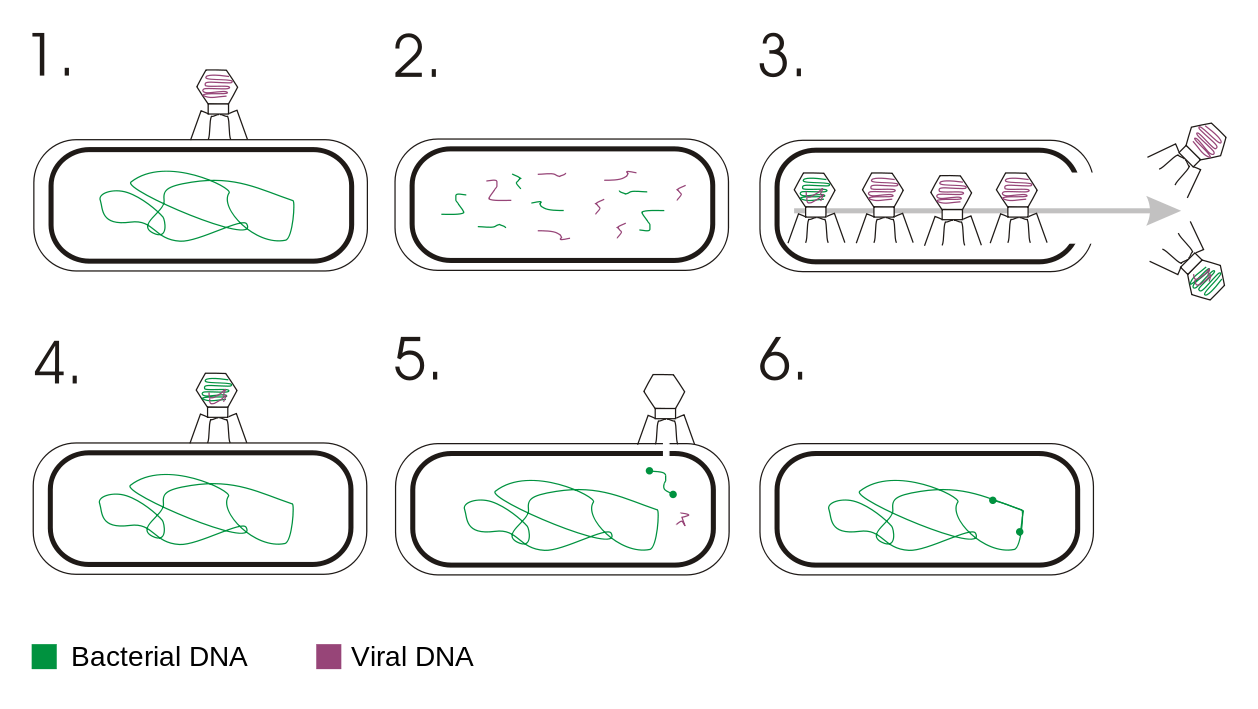Principles of Biochemistry/Expression of gene
Genes are composed of DNA, which contains information coded in the base pair sequences. They are then used as the blueprint for protein synthesis (gene expression). DNA consists of nucleic acid, adenine(A), guanine(G), cytosine(C), and thymine(T); while RNA consists of nucleic acid, adenine(A), guanine(G), cytosine(C), and uracil (U). RNA is usually single stranded while DNA is always double stranded. RNA can be found in both the nucleus and the cytoplasm. There are several types of RNA, all of which are involved in some aspect of protein synthesis: mRNA, tRNA, and rRNA.
Messenger RNA (mRNA)
 This shows the interaction of mRNA in a cell. Reference: wikipedia, author: Sverdrup.
This shows the interaction of mRNA in a cell. Reference: wikipedia, author: Sverdrup.
mRNA carries the complement of a DNA sequence and transport it from the nucleus to the ribosomes, where protein synthesis occurs. mRNA is assembled from ribonucleotides that are complementary to the "sense" strand of the DNA. The mRNA has the "inverted" complementary or negative codes of the original master on DNA. mRNA is monocistronic, for instance, one mRNA strand codes for one polypeptide.
Transfer RNA (tRNA)
 This depicts the tRNA binding to peptide. Reference: wikipedia, author: Boumphreyfr.
This depicts the tRNA binding to peptide. Reference: wikipedia, author: Boumphreyfr.
tRNA is a small RNA found in the cytoplasm that aids in the translation of mRNA's nucleotide code into a sequence of amino acids. tRNA brings amino acids to the ribosomes during protein synthesis. There is at least one type of tRNA for each amino acid; and there are about forty known types of tRNA.
Ribosomal RNA (rRNA)
rRNA is a structural component of ribosomes and is the most abundant of all RNA types. rRNA is synthesized in the nucleolus.
There are two major steps in gene expression: 1) transcription, and 2) translation.
In transcription, information coded in the base sequence of DNA is transcribed into a strand of mRNA that leaves the nucleus through nuclear pores. On the other hand, the remaining events of protein synthesis occur in the cytoplasm.
In translation, mRNA codes are translated into a sequence of amino acids. Translation occurs in the cytoplasm and involves tRNA, ribosomes, mRNA, amino acids, enzymes, and other proteins.
During protein synthesis, tRNA brings amino acids to the ribosomes in the correct sequence for polypeptide synthesis. tRNA recognizes both the amino acid and the mRNA codon. This dual function is reflected in its thee-dimensional structure: one end contains a three-nucleotide sequence, the anticodon, which is complementary to one of the mRNA codons; the other end is the site of amino acid attachment. Each amino acid has its own aminoacyl-tRNA synthetase, which has an active site that binds to both the amino acid and its corresponding tRNA, catalyzing their attachment to form an aminoacyl-tRNA complex.
Bacterial Genetics
The bacterial genome consists of a single circular chromosome located in the nucleoid region of the cell. Many bacteria also contain smaller circular rings of DNA called plasmids, which contain accessory genes. Episomes are plasmids that are capable of integration into the bacterial genome.
Replication
Replication of the bacterial chromosome begins at a unique origin of replication and preceeds in both directions simultaneously. DNA is synthesized in the 5' to 3' direction.
Genetic Variance
 This shows genetic variance in wheat, Reference: wikipedia, author: Shamgar331
This shows genetic variance in wheat, Reference: wikipedia, author: Shamgar331
Bacterial cells reproduce by binary fission and proliferate very rapidly under favorable conditions, Although binary fission is an asexual process, bacteria have three mechanisms for increasing the genetic variance of a population: transformation, conjugation, and transduction.
Transformation
Transformation is the process by which a foreign chromosome fragment (plasmid) is incorporated into the bacterial chromosome via recombination, creating new inheritable genetic combination.
Transduction
 Shows transduction of viruses.
Shows transduction of viruses.
Transduction occurs when fragments of the bacterial chromosome accidentally become packaged into viral progeny produced during a viral infection. These virions may infect other bacteria and introduce new genetic arrangements through recombination with the new host cell's DNA. The closer two genes are to one another on a chromosome, the more likely they will be to transduce together. This fact allows geneticists to map genes to a higher degree of precision.
Gene Regulation
 Shows gene expression control in cell. Reference: wikipedia, author: ArneLH
Shows gene expression control in cell. Reference: wikipedia, author: ArneLH
The regulation of gene expression (transcription) enables prokaryotes to control their metabolism. Regulation of transcription is based on the accessibility of RNA polymerase to the gene being transcribed and is directed by an operon, which consists of structural genes, an operator gene, and a promoter gene. Structural genes contain sequences of DNA that encode for proteins. The operator gene is the sequence of nontranscribable DNA that is the repressor binding site. The promoter gene is the noncoding sequence of DNA that serves as the initial binding sit for RNA polymerase. There is also a regulator gene, which codes for the synthesis of a repressor molecule hat binds to the operator and blocks RNA polymerase from transcribing the structural genes.
